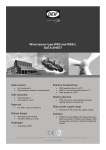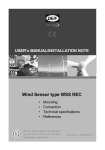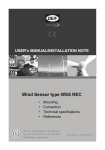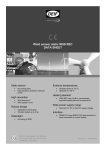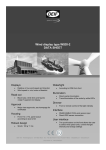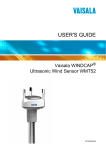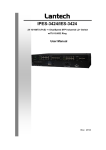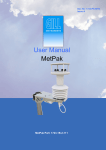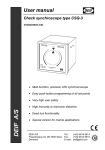Download WSS Installation and User Manual
Transcript
USER’s MANUAL/INSTALLATION NOTE Wind Sensor type WSS & WSS-L • • • • • Mounting Connecting Replace an old sensor Technical specifications References Document no.: 4189350026F WSS/WSS-L User’s Manual/Installation Note Table of contents 1. INTRODUCTION ......................................................................... 3 UNPACKING.................................................................................... 4 LEGAL INFORMATION AND RESPONSIBILITY ...................................... 4 2. MOUNTING THE WIND SENSOR ............................................. 5 PLACING OF THE WIND SENSOR...................................................... 5 BIRD AVOIDANCE KIT (OPTIONAL) .................................................... 7 3. CABLE CONNECTIONS............................................................. 8 THE WSS WIND SENSOR CABLE CONNECTIONS .............................. 8 CONNECTING A WSS OR WSS-L TO A WSDI-2 DISPLAY ................ 9 CONNECTOR KIT ASSEMBLY (OPTIONAL)....................................... 10 4. DIMENSIONS ............................................................................ 12 5. REPLACEMENT OF AN OLD WIND SENSOR....................... 13 6. TECHNICAL SPECIFICATION ................................................. 16 7. REFERENCES........................................................................... 19 DEIF A/S Page 2 of 19 WSS/WSS-L User’s Manual/Installation Note 1. Introduction This document provides guidelines for mounting and connecting the WSS and WSS-L static wind sensor. The WSS can be directly connected to the DEIF WSDI-2 wind display to form a complete wind system. WSS or WSS-L can also be used as wind sensor for previous DEIF wind displays like WSDI and 879, but in that case it must be connected via an interface box. The sensor may also be used as a component in a larger system; in that case the system must have a free RS485 or RS422 input with NMEA0183 capability. The ultrasonic wind measuring system used in the WSS is a fast responding and accurate system designed for measurement of wind speed and wind direction on-board ships. The sensor is based on three ultrasonic transducers arranged in a triangle for measuring of wind speed and wind direction. By measuring the time it takes for a set of ultrasound bursts to travel from each transducer to the other two, the wind speed and direction can be calculated. The wind sensor is available in two different versions: • The WSS with a built-in heater, which will automatically engage when risk of icing occurs during low temperatures. • The WSS-L without the heater is intended for applications in geographic areas where the risk of icing is very low or where occasional dropouts caused by icing are acceptable. Important: Please be aware that the term WSS will represent both WSS and WSS-L if no specific mentioning of the WSS-L is made. DEIF A/S Page 3 of 19 WSS/WSS-L User’s Manual/Installation Note Unpacking The WSS sensor is delivered in a cardboard box. To protect the delicate sensor heads, it is important to store it in the box until mounting. Do not hit, squeeze or try to remove the three black rubber hoods! The sensor is protected against ESD (static electricity), but it is recommended to avoid static discharge trough the connection wires during installation. Legal information and responsibility DEIF takes no responsibility for installation or operation of the wind measuring system. If there is any doubt about how to install or operate the WSS, the company responsible for the installation or the operation of the product must be contacted. The units are not to be opened by unauthorised personnel. If opened anyway, the warranty will be lost. DEIF A/S Page 4 of 19 WSS/WSS-L User’s Manual/Installation Note 2. Mounting the wind sensor Placing of the wind sensor Ideally, the wind sensor should be placed far from large objects that might influence the measuring results; however, in practice this is normally not possible on-board a ship. The best result is achieved by placing the wind sensor at the top of a mast in the opposite end of the superstructure. Placing the sensor just above the superstructure is disadvantageous, especially where the superstructure consists of wide side faces, over which the wind is forced. This may result in turbulence, velocities and wind directions that are out of proportion to the actual, undisturbed wind speed and wind direction. Keep away from the funnel. The wind sensor is intended for installation on a vertical socket or a tube using the stainless steel tap mounting base. See the drawing below for dimensions of the tap. The tap must not be removed from the wind sensor, as this will damage the waterproof sealing and warranty will become void. Do not expose the plastic part of the wind sensor to any torque when mounting the sensor. The tools used for fastening are only to be applied on the actual tap. DEIF A/S Page 5 of 19 User’s Manual/Installation Note ¾” pipe thread: Outer diameter: 1.04 inch (26.4mm), 14 threads per inch. 114.0 127.0 49.5 82.4 149.8 25.0 198.0 WSS/WSS-L IMPORTANT! The stainless steel mounting base on the WSS sensor must be connected to earth (e.g. the steel hull). To ensure that the display represents the precise wind direction relative to the ship, the wind sensor must be aligned correctly. I.e. when mounting the wind sensor, the arrow printed on the bottom of the sensor must point towards the stem of the ship and be parallel with the centre axis of the ship. On land-based installations, the arrow must point towards North. DEIF A/S Page 6 of 19 WSS/WSS-L User’s Manual/Installation Note Bird avoidance kit (optional) The Bird avoidance kit is designed to reduce the risk of birds landing on the WSS or WSS-L and thereby interfering with measurements or even damaging the sensitive ultrasonic transducer heads (the black rubber heads may attract some bird’s attention). The kit is an optional extra and is installed on top of the sensor. The spike system is designed not to hurt birds, but simply create a barrier to make it difficult for birds to land on top of the sensor. Please note, that the kit does not provide complete protection against birds, but especially large sea birds will not be able to land, while small birds may still be able to squeeze inn. Small birds may interrupt the wind measurement but will not be able to damage the sensor. The shape and location of the spikes have been designed so that the interference with wind measurements is negligible. It is recommended to use the kit if there is a high accumulation of birds in the area where the sensor is used. When the kit is mounted on the WSS sensor, more snow may be able to accumulate on top of the sensor and it may melt slower. Installation of the kit 1. Position the metal ring with spikes around the stainless steel top plate of the WSS/WSS-L sensors. Position it so that the spikes do not block the direct paths between the three black rubber heads, see picture. 2. Secure the metal ring using the M3x6 screw provided. It is recommended to secure the screw from loosening due to vibrations with a drop of Loctite® super glue or equivalent (not included in the kit) and tighten the screw all the way in. 3. Check that the kit sits tightly on the WSS/WSS-L DEIF A/S Page 7 of 19 WSS/WSS-L User’s Manual/Installation Note 3. Cable connections The wind sensor is supplied with 2 metres fixed cable. From factory, the cable is connected to the sensor via a waterproof gland, and this must not be replaced by another cable. The cable can be extended by using the connection box kit or the IP67 connector kit (both optional). In order to protect the wind sensor and the personnel in the best possible way from lightning strokes, use a lightning rod installed with the tip at least one metre above the wind sensor. The lightning rod must be properly grounded in compliance with all applicable safety regulations. The wind sensor cable screen and the extension cable screen must be connected. For further protection of the cable between the wind sensor and the connection box, as well as the installation cable between the connection box and the interface box, it is recommended to use a metal conduit pipe. If the instrument is installed in a metal panel, this panel has to be carefully earthed, as well as the instrument itself. Suitable extension cable is available from DEIF at any length between 1 and 300 meter. Alternatively, an installation cable, e.g. UL2464 2 18AWG4C + AE, 4 x 0.75mm screened, can be used. The max. length is 300m, and maximum 70nF capacity between the signal conductors. The WSS wind sensor cable connections Cable colour Black Red Orange Brown Shield Function Supply voltage RS485 comm. Cable shield Note + A B 9 - 31V DC supply for the WSS wind sensor Wind speed and direction data output Is connected to the stainless steel tap inside the WSS. No supply voltage must be present during installation of the wind sensor, as this will damage the wind sensor. DEIF A/S Page 8 of 19 WSS/WSS-L User’s Manual/Installation Note Connecting a WSS or WSS-L to a WSDI-2 display WSS/WSS-L WSDI-2 DC power source + WSDI-2 1. 2. …. 7. 8. 9. Conn. kit (Optional) Ground (Earth) the sensor tap T The data bus must be terminated with the resistor supplied with the WSDI-2 Wind sensor WSS/WSS-L Cable colour Black (-) Display WSDI-2 Terminal no.: 1. 0V Red 2. VCC (+) Orange (A) Brown (B) Screen 7. A 9. B 8. Data GND Description Comments Aux. voltage: 0V Aux. voltage: +12 or 24V DC Aux. voltage to WSDI-2 and WSS are parallel-coupled in the terminal block RS485 data communication Cable screen Data A Data B Cable screen See also: WSDI-2 User’s Manual/Installation Note no. 4189350032. DEIF A/S Page 9 of 19 WSS/WSS-L User’s Manual/Installation Note Connection of other equipment One standard NMEA0183 input for a VDR or integrated navigation system can be connected to terminal A and B (see also chapter 6 – Interface). It is recommended to use a NMEA-buffer if more than one NMEA input has to be connected. Connector kit assembly (Optional) The connectors must be soldered onto the cable according to the following instructions: WSS/WSS-L fixed cable Connector pin no. WSS extension cable Male connector Female connector Plug Male 7 pin. 10 22 00 00 52 Plug female 7 pin. 10 22 00 00 53 Screw cap male, 10 29 92 00 02 Screw cap female, 10 29 92 00 03 Black (-) Red (+) Orange Brown Screen DEIF A/S ● ● ● ● ● 1 2 3 4 5 Black (-) Red (+) Orange Brown Screen Signal comments ● ● ● ● ● 30V DC Supply for WSS/WSS-L RS485 Comm. from WSS/WSS-L Cable screen Page 10 of 19 WSS/WSS-L User’s Manual/Installation Note Measures are in mm. DEIF A/S Page 11 of 19 WSS/WSS-L User’s Manual/Installation Note DEIF A/S ¾” pipe thread: Outer diameter: 1.04 inch (26.4mm), 14 threads per inch. 114.0 127.0 49.5 82.4 149.8 198.0 4. Dimensions Page 12 of 19 WSS/WSS-L User’s Manual/Installation Note 5. Replacement of an old wind sensor type 879.3c by the new WSS Replacing 879.3c WSS/WSS-L WSI 879.50/879.521 or WSDI The special upgrade kit should be used when an existing 879.3c dynamic wind sensor has to be replaced with a new WSS or WSS-L sensor and connected to a display type 879.50/879.521 or WSDI. The interface box type WSI is needed to translate the RS485 data signal from WSS into a speed and direction TTL signal appropriate for the 879.50/879.521 or WSDI display. Remove the tap for the old sensor 879.3c and mount the new sensor. Notice that the tap is fixed on the new sensor and is not to be removed. Mount the new sensor so the arrow on the bottom of the sensor is pointing towards the stem of the ship. Do not expose the plastic part of the wind sensor to any torque when mounting the sensor; the tools used for fastening are only to be applied on the actual tap. The existing cable can be used. Before mounting the new sensor using the existing cable, remember to disconnect the cable from the wind display and check that the cable is not damaged. DEIF A/S Page 13 of 19 WSS/WSS-L User’s Manual/Installation Note The sensor is equipped with a 2m cable, this cable is connected to the existing cable using a junction box (normally already mounted). The interface box can be mounted anywhere between the sensor and the display(s), but the following must be taken into consideration: the interface box has to be supplied from a 24V DC/1.25A source and mounted indoor, for which reason it is recommended to mount the interface box close to the existing display(s). Wind sensor WSS Cable colour Interface box WSI Terminal no.: Black (-) Red (+) Orange (A) Brown (B) Screen 9 - WSS supply 7 + WSS supply 4 Input A 5 Input B 61 – Power 2 + Power 12 - (0V) 11 D 10 S Display WSDI Terminal no.: Comments 30V DC supply for the WSS RS485 comm. from WSS Cable screen (earth) Aux. supply 18-32V DC, 1.25A 2 0V 4 Direction 3 Speed 5 Screen AC AC GND/Earth 1 +5V A Signal B Return Screen 9 10 11 Wind direction (D) and wind speed (S) Screen Aux. supply 110V AC or 220V AC Ground +5V DC for external mode shift/dimmer NMEA0183 output External mode shift/dimmer, see document no. 4189350009 IMPORTANT! The stainless steel mounting base of the WSS sensor must be connected to earth (e.g. the steel hull). DEIF A/S Page 14 of 19 WSS/WSS-L User’s Manual/Installation Note 4.5 WSI interface box dimensions: 85.0 61.0 75.0 99.7 110.0 Before the replacement is carried out, it is recommended to carefully read the User's Manual/Installation Note (this document). DEIF A/S Page 15 of 19 WSS/WSS-L User’s Manual/Installation Note 6. Technical specification Sensors are designed according to the standards below Power supply Power consumption Interface Data sentence Wind speed Wind direction DEIF A/S 12/24V (9.0…31.2V DC) WSS-L and WSS with inactive heating element: < 0.1W WSS with maximum heating < 15W RS485 (I/O) operation: The bus should be terminated with 120 to 200 ohm for pure RS485 operation. Standards NMEA 0183 ver. 2.x-3.0 Combined RS485 (I/O) and NMEA0183 (I) operation: A combination of up to ten RS485 (I/O) and one NMEA0183 listeners can be connected to the WSS data interface at the same time. The data line must be terminated with a 200 to 250ohm resistor to obtain > +/- 2.1V output necessary for a standard NMEA0183 input circuit to work. The NMEA0183 input load must be < 2mA @ +/- 2V. NOTE: A NMEA-buffer is recommended if connection of more than one standard NMEA input is needed. $WIMWV – Wind speed and direction data $WIXDR – Transducer Measurement NMEA 0183 Response ver. 3.0 $WITXT – Error messaging For details see doc. no. 4189350028 Appendix to User's Manual, Wind measuring system Range: 0….116 KTS (0….60m/s) Resolution: 0.1 Knots Accuracy: 0…68 KTS: ±0.6 KTS or ±3%, whichever is greater > 68 KTS: ±5% Range: Resolution: Accuracy: o 0…. 360 continuously o 1 ±3% in relation to wind direction Page 16 of 19 WSS/WSS-L Update interval Start-up time Connection Mounting User’s Manual/Installation Note 1 second < 5 sec. from power on to valid data output 2 2 meter 4 x 0.75mm screened cable type UL2464 18AWG/4C+DW+AL/MY+Jacket. The 2m cable is fixed mounted on the sensor and is open-ended. ¾” pipe thread: Outer diam: 1.04 inch (26.4mm), 14 threads per inch. Compass safety 0.2 meter distance Protection Relative humidity Pressure IEC 945 and EN 60945 IEC 529 and EN 60529 EN/IEC 60068-1/2 IP66 0…100% 600…1100hPa WSS operating range: -52…+60°C (class approved for: -25…+60°C) WSS-L operating range: 0…60°C (see note) Temperature EN 60051 Storage (both): -60…+70°C Note: WSS-L has no automatic heating element to prevent ice, the sensor will work below 0°C but it will depend on weather conditions. Vibration test Safety EMC Housing Weight DEIF A/S 3…13.2Hz: 2mm (peak-peak) 13.2…100Hz: 0.7g 3…15Hz: + 2.5mm (peak) 15…50Hz: 2.3g Cat.III, poll.dg.2, 550V AC rms, 50Hz, 1 minute CE-marked for industrial environment Wind sensor housing: Polycarbonate +10% glass fibre Mounting tap: Corrosion-resistant stainless steel EN 60945, EN/IEC600682-6 and DNV Class A GL curve 4 for masts EN 61010-1 EN 61000-11/2/3/4 UL94 V0 0.8 kg Page 17 of 19 WSS/WSS-L User’s Manual/Installation Note Dimensions, cardboard box 450 x 315 x 230 Approvals Type-approved according to: (See www.deif.com for certificates and details) Accessories GL, DNV, CCS, RS and GOST-R IP66 Connection box kit: IP66 Connection box w/ cable glands and screw terminals to extend the sensor cable with an extension cable IP67 Connector kit: water tight male and female connector for soldering to respectively the sensor cable and the extension cable. Extension cable: 1 to 300m shielded cable DEIF id.no.1020230016 Bird avoidance kit: Spike kit to prevent birds from interrupting the wind measurements or in worst case from damaging the sensor. DEIF A/S Page 18 of 19 WSS/WSS-L User’s Manual/Installation Note 7. References For more details see: WSDI-2 User’s Manual/Installation Note, document no. 4189350032. Appendix to User’s Manual, Wind measuring systems, document no. 4189350028. Documentation is available on www.deif.com – Download centre. DEIF A/S reserves the right to change any of the above. DEIF A/S Page 19 of 19



















